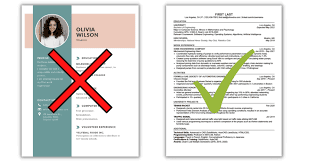Bad Resume Examples: Mistakes to Avoid While Crafting a Resume
Published on October 2nd, 2024
Your resume is your first impression, and the phrase goes that "You never get a second chance to make a first impression." In actuality, job seekers sabotage their own potential for success through a number of common mistakes below-stuff that is quite easily avoided. In this blog post, we discuss some of the most common mistakes and, correspondingly, how to avoid them in order to create a truly brilliant resume.
Bad Resume Examples
Example No: 1
- Don't center everything! The less said about this the better, especially in regard to bullet points.
- It is a bit of a balance between not using enough white space, but then again, using too much. Balance the text with white space around it.
- Don't use the same typeface weight or size. It's hard to see where categories start and stop.
Example No: 2
- It's just too much color and it looks like an American "theme" gone wrong. It also looks a little like a cheap advertisement… "Step right up folks, here's your chance…"
- Colour variation disunites categories and thus reduces unity. Nothing seems to be like it belongs together.
- This one's margins look pretty good, though. Nice "breathing" room
Example No: 3
- The margins are too small on this bad resume. It looks like you’ve crammed everything into a little space—too crowded. Margins and white space let your words and design “breathe.”
- Don't italicize your headlines. It makes them look like the logo on a hockey team, or that they are in some sort of race.
- Don't use anything over an 11-point font for body copy; it looks too bulky and unprofessional.
What are the Mistakes to Avoid on the Resume?
Unnecessary Information Overload
The mistake:
Including every job one has ever had, irrelevancies, or personal information that does not bear on the job being applied for.
Why It's Bad:
Many hiring managers spend only a few seconds scanning a resume. If yours is filled with unimportant information, that is going to make it much more difficult for them to catch your relevant experience and experience and skills.
How to Correct It:
Summarize experiences and skills relevant to the applied position. Tailor your resume to each job by giving more details on the most relevant parts of your work history. Do not include personal information, like age, marital status, and hobbies, unless it is highly relevant.

The Use of a One-Size-Fits-All Resume
Mistake Made:
Sending the same generic resume for every job application.
Why it's bad:
Your resume, not tailored to the specific job, will more than likely just blend into the background. Employers want to see you made an attempt to understand them and how you'd be able to satisfy their needs.
How to Fix It:
The key to a great resume is that it is tailored for each job, which usually means a rewrite of the objective statement, rearrangement of bullet points to bring out relevant experience, and adjustment of keywords to fit the description. Yeah, it's more work, but it's worth it.
Being Vague or Using Overused Buzzwords
The Mistake: You compose your resume with a great deal of vague statements or repeat overused buzzwords like "hard worker," "team player," or "detail-oriented" without proof that you are.
Why It's Bad:
These phrases have lost their impact because they are so overused. Without concrete examples, they don't tell the hiring manager anything meaningful about your abilities.
How to Improve It:
Be specific. Give quantifiable achievements. Instead of saying you're a "team player," mention any project where your contribution toward working in a team resulted in success. Use numbers to support your achievements whenever possible; for example, "Increased sales 20% over six months."
4. Poor Formatting and Lack of Readability
The Mistake:
Layout is too complicated, fancy fonts are used, or too much text fits on one page.
Why it's bad:
If your resume is, frankly, a pain to read, hiring managers won't. A cluttered or overly complicated resume detracts from anything that might actually be on the page and makes key points harder to discern.
How to Fix It: Do-adopt a clean, professional layout. Stick to a simple, readable font, such as Arial or Calibri, and leave plenty of white space. Unless you have a lot of experience, stick to one page; if you do have much experience, two pages may be called for. Use bullet points to help clarify information and well-marked sections.
Typos and Grammatical Errors
The Mistake:
Sending out a resume with spelling mistakes, typos, or grammatical errors.
Why It's Bad:
Errors on your resume indicate the lack of attention to detail and can be one of those red flags for an employer, especially in roles that require your attested communication skills.
How to Rectify:
You should proofread your resume several times, and you may want to have someone else look at it, too. Sometimes, another pair of eyes finds errors that you never noticed. Tools like Grammarly also help; these tools can catch basic errors.
Final Thoughts
All of these very basic mistakes on resumes make all the difference in the world in your job searching. Remember that very often, your resume is an initial contact with a would-be employer; hence, take this chance and make the most of it. By keeping your resume concise, tailored to a specific job applied for, well-formatted, and error-free, you will get more chances to be invited for an interview and eventually get the job.
Authors

Yash Chaudhari
With a strong background as an SEO and Content Specialist, Yash excels in driving organic traffic, improving search engine rankings, and creating SEO-optimized content. He has a proven track record of implementing strategies that increase website traffic and conversions. Additionally, Yash is an automotive enthusiast and has a keen interest in astronomy.
Hire the best without stress
Ask us how
Never Miss The Updates
We cover all recruitment, talent analytics, L&D, DEI, pre-employment, candidate screening, and hiring tools. Join our force & subscribe now!
Stay On Top Of Everything In HR

